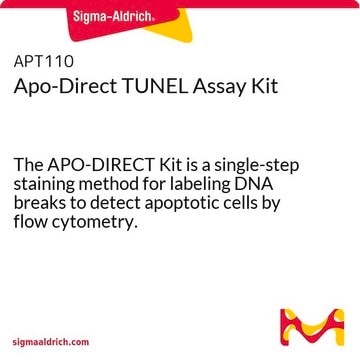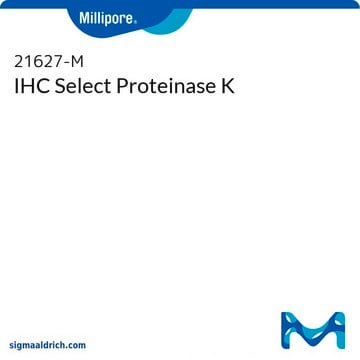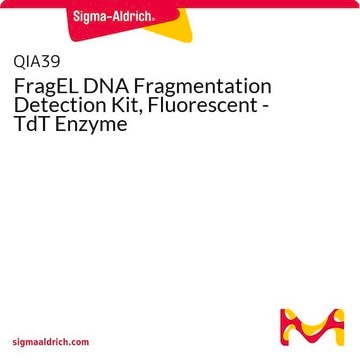S7101
ApopTag Plus Peroxidase In-Situ-Apoptose-Kit
The ApopTag Plus Peroxidase In Situ Apoptosis Detection Kit detects apoptotic cells by labeling & detecting DNA strand breaks by the indirect TUNEL method.
Synonym(e):
In-Situ-Apoptose-Nachweiskit
About This Item
Empfohlene Produkte
Qualitätsniveau
Hersteller/Markenname
ApopTag
Chemicon®
Nachweisverfahren
colorimetric
Versandbedingung
dry ice
Allgemeine Beschreibung
Die ApopTag Peroxidase-Kits wurden getestet und sind für die Verwendung in der histochemischen und zytochemischen Färbung folgender Proben geeignet: formalinfixiertes, in Paraffin eingebettetes Gewebe, kryostatische Schnitten, Zellsuspensionen, Zytospins und Zellkulturen. Methoden für Ganzpräparate (Whole-Mount) wurden entwickelt (34, 45). (Siehe Datenblatt, Abschnitt V. für Literaturverweise).
Die Färbungsspezifität der ApopTag Peroxidase-Kits wurde von Chemicon und von vielen anderen Labors nachgewiesen. Chemicon hat viele Arten von Modellzellen- und Gewebesystemen geprüft, einschließlich: (a) Prostata, Thymus und Dickdarm des Menschen (interne Daten); (b) ventrale Prostata der Ratte nach Kastration (21), (c) in vitro mit Dexamethason (3, 13) behandelte Thymuslymphozyten der Ratte; (d) Gliedmaßen eines 14 Tage alten Mausembryos (1) und (e) nach dem Abstillen sich zurückbildende Brustdrüsen der Ratte (36). In den Thymozyten- und Prostatamodellen wurde Agarosegelelektrophorese zur Beurteilung der DNA-Leiter (Menge) verwendet, die zufälligerweise gleichzeitig mit der höchsten Prozentzahl an gefärbten Zellen ihren Höhepunkt erreichte. Die Nützlichkeit der ApopTag-Kits wurde in zahlreichen Journalen und Publikationen von weltweiten Labors bestätigt. (Siehe Datenblatt, Abschnitt V. Literatur, Publikationen mit Zitierung der ApopTag-Kits).
Anwendung
ApopTag In Situ Apoptosis Detection Kits label apoptotic cells in research samples by modifying DNA fragments utilizing terminal deoxynucleotidyl transferase (TdT) for detection of apoptotic cells by specific staining.
This manual contains information and protocols for the ApopTag Plus In Situ Apoptosis Detection Kit.
Principles of the Procedure
The reagents provided in ApopTag Peroxidase Kits are designed to label the free 3′OH DNA termini in situ with chemically labeled and unlabeled nucleotides. The nucleotides contained in the Reaction Buffer are enzymatically added to the DNA by terminal deoxynucleotidyl transferase (TdT) (13, 31). TdT catalyzes a template-independent addition of nucleotide triphosphates to the 3′-OH ends of double-stranded or single-stranded DNA. The incorporated nucleotides form an oligomer composed of digoxigenin-conjugated nucleotide and unlabeled nucleotide in a random sequence. The ratio of labeled to unlabeled nucleotide in ApopTag Peroxidase Kits is optimized to promote anti-digoxigenin antibody binding. The exact length of the oligomer added has not been measured.
DNA fragments which have been labeled with the digoxigenin-nucleotide are then allowed to bind an anti-digoxigenin antibody that is conjugated to a peroxidase reporter molecule (Figure 1A). The bound peroxidase antibody conjugate enzymatically generates a permanent, intense, localized stain from chromogenic substrates, providing sensitive detection in immunohistochemistry or immunocytochemistry (i.e. on tissue or cells). This mixed molecular biological-histochemical systems allows for sensitive and specific staining of very high concentrations of 3′-OH ends that are localized in apoptotic bodies.
The ApopTag system differs significantly from previously described in situ labeling techniques for apoptosis (13, 16, 38, 46), in which avidin binding to cellular biotin can be a source of error. The digoxigenin/anti-digoxigenin system has been found to be equally sensitive to avidin/biotin systems (22). The sole natural source of digoxigenin is the digitalis plant. Immunochemically-similar ligands for binding of the anti-digoxigenin antibody are generally insignificant in animal tissues, ensuring low background staining. Affinity purified sheep polyclonal antibody is the specific anti-digoxigenin reagent used in ApopTag Kits. This antibody exhibits <1% cross-reactivity with the major vertebrate steroids. In addition, the Fc portion of this antibody has been removed by proteolytic digestion to eliminate any non-specific adsorption to cellular Fc receptors.
Results using ApopTag Kits have been widely published (see Sec. V. References, Publications Citing ApopTag Kits). The ApopTag product line provides various options in experimental design. A researcher can choose to detect staining by brightfield or fluorescence microscopy or by flow cytometry, depending on available expertise and equipment. There are also opportunities to study other proteins of interest in the context of apoptosis when using ApopTag Kits. By using antibodies conjugated with an enzyme other than peroxidase and an appropriate choice of substrate, it is possible to simultaneously examine another protein and apoptosis using ApopTag Peroxidase Kits.
Komponenten
Reaktionspuffer 91417 2,0 ml -15 °C bis -25 °C
TdT-Enzym 90418 0,672 ml -15 °C bis -25 °C
Stopp-/Waschpuffer 90419 20 ml -15 °C bis -25 °C
Anti-Digoxigenin-Peroxidase* 90420 3,0 ml 2 °C bis 8 °C
Kunststoff-Deckgläser 90421 je 100 St. Raumtemp.
Kontrollobjektträger 90422 je 2 St. Raumtemp.
DAB-Substrat 90423 130 μl 2 °C bis 8 °C
DAB-Verdünnungspuffer 90424 6,5 ml 2 °C bis 8 °C
*affinitätsgereinigter polyklonaler Antikörper vom Schaf
Anzahl von Proben pro Kit: Es werden ausreichend viele Materialien zur Verfügung gestellt, um bei einer anleitungsgemäßen Verwendung 40 Gewebeproben von jeweils ca. 5 cm2 zu färben. Wenn die Kits für Proben auf Objektträgern verwendet werden, wird der Reaktionspuffer vor Einsatz anderer Reagenzien vollständig aufgebraucht.
Lagerung und Haltbarkeit
Vorsichtshinweise
1. Die folgenden Komponenten des Kits enthalten Kaliumcacodylat (Dimethylarsinsäure) als Puffer: Äquilibrierungspuffer (90416), Reaktionspuffer (90417) und TdT-Enzym (90418). Diese Komponenten sind bei Verschlucken gesundheitsschädlich; Kontakt mit Haut und Augen vermeiden (Handschuhe, Schutzbrille tragen) und Kontaktbereiche sofort abwaschen.
2. Es wurde nachgewiesen, dass DAB (3,3′-Diaminobenzidin)-Substrat (90423) ein potenzielles Karzinogen ist, weshalb jeglicher Hautkontakt zu vermeiden ist. Im Fall eines Hautkontakts, die Haut mit reichlichen Mengen dH2O abspülen.
3. Antikörperkonjugate (90420), enthält 0,08 % Natriumazid als Konservierungsmittel.
4. TdT-Enzym (90418) enthält Glycerin und gefriert bei -20 °C nicht. Für eine maximale Haltbarkeitsdauer dieses Reagenz vor der Entnahme nicht auf Raumtemperatur erwärmen.
Rechtliche Hinweise
Haftungsausschluss
Signalwort
Danger
H-Sätze
Gefahreneinstufungen
Aquatic Chronic 2 - Carc. 1B - Muta. 2 - Skin Sens. 1 - STOT RE 2 Inhalation
Zielorgane
Respiratory Tract
Lagerklassenschlüssel
6.1C - Combustible acute toxic Cat.3 / toxic compounds or compounds which causing chronic effects
Analysenzertifikate (COA)
Suchen Sie nach Analysenzertifikate (COA), indem Sie die Lot-/Chargennummer des Produkts eingeben. Lot- und Chargennummern sind auf dem Produktetikett hinter den Wörtern ‘Lot’ oder ‘Batch’ (Lot oder Charge) zu finden.
Besitzen Sie dieses Produkt bereits?
In der Dokumentenbibliothek finden Sie die Dokumentation zu den Produkten, die Sie kürzlich erworben haben.
Kunden haben sich ebenfalls angesehen
Artikel
Cellular apoptosis assays to detect programmed cell death using Annexin V, Caspase and TUNEL DNA fragmentation assays.
Unser Team von Wissenschaftlern verfügt über Erfahrung in allen Forschungsbereichen einschließlich Life Science, Materialwissenschaften, chemischer Synthese, Chromatographie, Analytik und vielen mehr..
Setzen Sie sich mit dem technischen Dienst in Verbindung.














